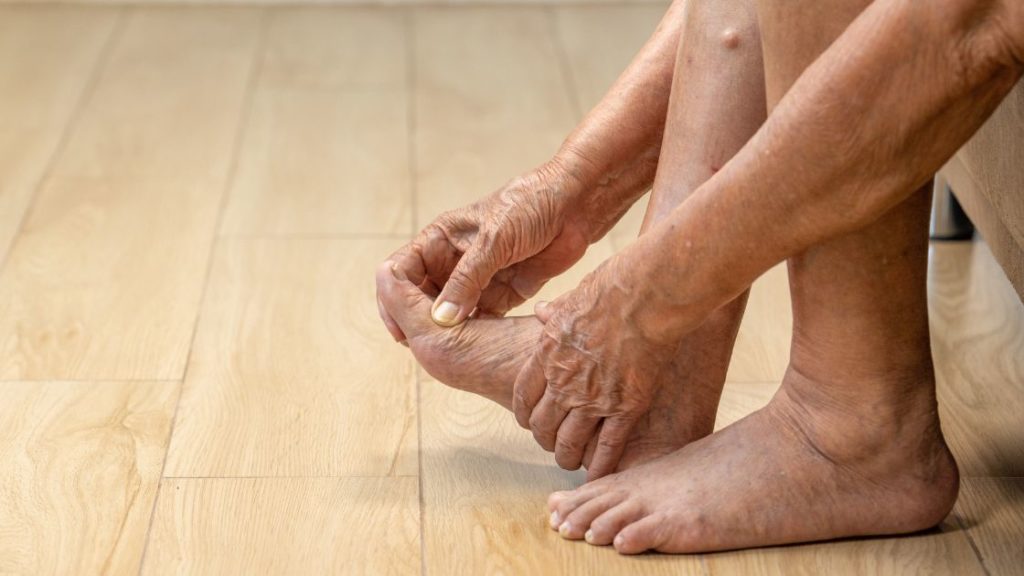Treating Gout with Massage

Gout is a common type of arthritis that causes tenderness, severe pain, redness, and swelling in the joints. The condition is caused by high levels of uric acid, a waste product found in the blood, which causes a buildup of sharp crystals around the joints.
While sudden gout attacks can occur in any joint in the body, they most often affect the big toe. Though they can strike at any time of day, the episodes tend to arise in the middle of the night.
There is currently no cure for gouty arthritis. However, did you know that bodywork can both ease the discomfort and ward off the possibility of further joint damage? Massage therapy is a commonly sought remedy for treating all types of arthritis, and a regular massage routine can keep gout in remission.
What are the signs that gout may be surfacing? What are the causes, and who is at highest risk? How is bodywork applied for gout treatment?
Signs of Gout
Look for the symptoms in the toes, ankles, knees, wrists:
- Intense pain and tenderness in the joints
- A hot sensation in or around the joints
- Joint stiffness or disfigurement
- Edema near affected area
- Redness and/or shiny skin over the joint
- Itchy flaky skin around affected area – Takes place when other symptoms of a gout attack have subsided
Causes of Gout
What factors coincide with excessive uric acid levels?
- Obesity
- Diabetes
- Hypertension
- Kidney problems
- Lead exposure
- Excessive alcohol consumption
- Diet – Foods that can cause a uric acid buildup include red meat, organ meat, and seafood
Who is at Highest Risk?
- Men aged 30-50
-
- Women comprise only 5% of the people living with gout in the US
-
- People with a family history of gout
- Organ transplant patients
-
- Reduced uric acid excretion is common following an organ transplant
-
- Asian Pacific Islanders
- African Americans
Our Approach to Gout Treatment
At Moyer Total Wellness, we have four goals when it comes to treating any musculoskeletal condition: remove knots from muscular tissue, strengthen weak muscles, lengthen constricted tissues, and improve joint mobilization.
The ideal massage for gout is going to target the high uric acid levels in the blood and flush them from the body. The good news is that pretty much all massage modalities improve your blood flow, and healthy circulation plays a crucial role in muscular health. Shortened and knotted muscular tissue results from congested blood flow. Blood delivers nutrients and oxygen to the muscular tissue, and an undernourished muscle won’t function optimally. Dysfunction will lead to underuse or poor body mechanics, which will in turn weaken the muscle and impair joint range of motion. With all that said, is there a type of massage that stands out amongst all the others when it comes to gout treatment? Lymphatic drainage might be the best massage modality to explore first!
Lymphatic drainage massage is a specialized therapeutic massage that manually moves lymphatic fluid towards the lymph nodes located throughout the body. When the lymphatic system isn’t functioning properly, uric acid won’t easily exit the body, which leads to the crystallization on the joints and swelling of the bodily tissues. An improved lymphatic system will naturally flush the excessive uric acid from the body, thereby reducing the edema as well as the crystallized buildup surrounding the gouty joints. The reduction of crystallization will free the space between the joints, increasing joint range of motion, putting the joints in a good place to practice proprioceptive neuromuscular facilitation for flexibility and low-intensity strength training purposes!
Now You Know!
Keep the gout out!
Katrina Jenkins
Author, Licensed Massage Therapist
Katrina Jenkins graduated from Towson University in 2013 with a Bachelor’s Degree in Health Science and worked as a nurse’s aide briefly before pursuing her true passion. She graduated from the Massage Therapy Institute of Colorado in April 2016 with honors and completed the Touch of Healers Scholarship Program the following summer. She has been a part of the Moyer Total Wellness Team since the summer of 2017.
Resources
Braun, Ashley. “Foods That Increase Uric Acid.” Verywell Health, 21 Jan. 2022, www.verywellhealth.com/uric-acid-foods-5093036#:~:text=High%2DPurine%20Foods&text=Alcohol%3A%20All%20types.
Evans, Peter L., et al. “Gender-Specific Risk Factors for Gout: A Systematic Review of Cohort Studies.” Advances in Rheumatology, vol. 59, no. 1, 24 June 2019, 10.1186/s42358-019-0067-7.
Higuera, Valencia. “Symptoms of Gout.” Healthline, Healthline Media, 30 Oct. 2014, www.healthline.com/health/gout-symptoms.
“Who Is at Risk for Gout? | American Kidney Fund.” Www.kidneyfund.org, 11 Nov. 2021, www.kidneyfund.org/living-kidney-disease/health-problems-caused-kidney-disease/gout/who-risk-gout.
Photo Credit
Canva by akaratwimages
Canva by toeytoey2530
Canva by toeytoey2530
